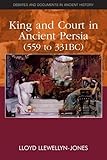King and Court in Ancient Persia 559 to 331 BCE / Lloyd Llewellyn-Jones.
Material type: TextSeries: Debates and Documents in Ancient History : DDAHPublisher: Edinburgh : Edinburgh University Press, [2022]Copyright date: ©2013Description: 1 online resource (272 p.) : 23 B/W illustrations 1 B/W tablesContent type:
TextSeries: Debates and Documents in Ancient History : DDAHPublisher: Edinburgh : Edinburgh University Press, [2022]Copyright date: ©2013Description: 1 online resource (272 p.) : 23 B/W illustrations 1 B/W tablesContent type: - 9780748641260
- 9780748677108
- 935.705 23
- online - DeGruyter
| Item type | Current library | Call number | URL | Status | Notes | Barcode | |
|---|---|---|---|---|---|---|---|
 eBook
eBook
|
Biblioteca "Angelicum" Pont. Univ. S.Tommaso d'Aquino Nuvola online | online - DeGruyter (Browse shelf(Opens below)) | Online access | Not for loan (Accesso limitato) | Accesso per gli utenti autorizzati / Access for authorized users | (dgr)9780748677108 |
Browsing Biblioteca "Angelicum" Pont. Univ. S.Tommaso d'Aquino shelves, Shelving location: Nuvola online Close shelf browser (Hides shelf browser)

|

|

|

|

|

|

|
||
| online - DeGruyter Remembering the Past in Nineteenth-Century Scotland : Commemoration, Nationality and Memory / | online - DeGruyter Women and the Railway, 1850-1915 / | online - DeGruyter Stiegler and Technics / | online - DeGruyter King and Court in Ancient Persia 559 to 331 BCE / | online - DeGruyter The Poetry of Jack Spicer / | online - DeGruyter Arabic Corpus Linguistics / | online - DeGruyter The Hollywood Meme : Transnational Adaptations in World Cinema / |
Frontmatter -- Contents -- Series Editors’ Preface -- Preface -- A Note on Abbreviations -- Timeline -- Map of the Persian Empire -- Map of Iran -- Plan of the Terrace at Persepolis -- Part I Debates -- Part II Documents -- Further Reading -- Internet Resources -- Bibliography -- Index
restricted access online access with authorization star
http://purl.org/coar/access_right/c_16ec
The first Persian Empire (559-331 BCE) was the biggest land empire the world had seen, and seated at the heart of its vast dominions, in the south of modern-day Iran, was the person of the Great King. Immortalized in Greek literature as despotic tyrants, a new vision of Persian monarchy is emerging from Iranian, and other, sources (literary, visual, and archaeological), which show the Kings in a very different light. Inscriptions of Cyrus, Darius, Xerxes, and their heirs present an image of Persian rulers as liberators, peace-makers, valiant warriors, righteous god-fearing judges, and law-makers.Around them the Kings established lavish and sophisticated courts, the centres of political decision-making and cultural achievements in which the image of monarchy was endorsed and advanced by an almost theatrical display of grandeur and power.This book explores the representation of Persian monarchy and the court of the Achaemenid Great Kings from the point of view of the ancient Iranians themselves and through the sometimes distorted prism of Classical authors.
Mode of access: Internet via World Wide Web.
In English.
Description based on online resource; title from PDF title page (publisher's Web site, viewed 29. Jun 2022)


